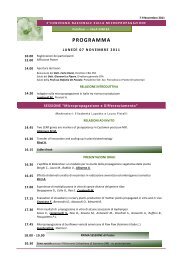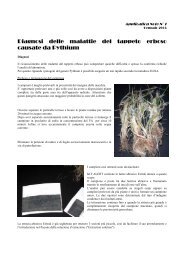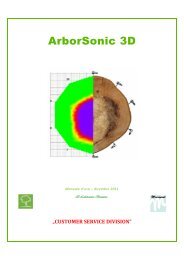BIOLOGY - microscopia.info
BIOLOGY - microscopia.info
BIOLOGY - microscopia.info
You also want an ePaper? Increase the reach of your titles
YUMPU automatically turns print PDFs into web optimized ePapers that Google loves.
112<br />
Overhead Transparency Atlases<br />
regions, diagram - Build-ups, weirs protect from high water and serve to raise the ground-water level - Line of waterlevel<br />
duration and profile of bank vegetation - Change of the transverse profile to shade the water and lower its temperature,<br />
diagram - Installation of small steps on the bed to raise the water-level - a) steps of local stone, - b) groynes and<br />
disturbing stones support the dynamic development of the water - Protected by trees and shrubs, the water gradually<br />
runs a natural course with undercut bank and slope. - Fish ladders improve biotope - Measures to protect flat and steep<br />
coasts, diagram - Active cliff - Marram grass (Ammophila arenaria) fixes shores and dunes<br />
Water tests and survey. Test of water quality: determination of temperature - Test of water quality: electrometrical<br />
determination of oxygen content, conductivity, and pH - Taking water samples: measuring contents of oxygen, conductivity<br />
and pH with electric gauge - Analysis of water in the laboratory - Fully automatic testing of water in laboratory<br />
installed close to a river<br />
Grades of waters. Grade I: pure water zone of a mountain creek (oligosaprobic zone) - Bioindicators (organisms) of<br />
grade I (oligosaprobic zone) - Grade II: moderately polluted surface water (beta-mesosaprobic zone) - Bioindicators<br />
(organisms) of grade II = Moderately polluted zone (beta-mesosaprobic zone) - Grade III: heavily, critically polluted<br />
surface water (alpha-mesosaprobic zone) - Bioindicators (organisms) of grade III = heavily polluted zone (alpha-mesosaprobic<br />
zone) - Grade IV: extremely polluted superficial water (polysaprobic zone) - Bioindicators (organisms) of grade<br />
IV = extremely polluted zone (polysaprobic zone) - Extremely polluted water (grade IV, polysaprobic zone) of an oasis<br />
- Water grades between source and mouth of a river, graph - Subdivision of a running water according to degree of<br />
organic pollution, grades of saproby, saproby index, identifying colors, and oxygen minima - Chemical criteria for grades<br />
of biological pollution, table - Classification of running waters according to bacteriological findings<br />
Pollution of waters by introduction of sewage. Cycle of organic substances in the water, diagram - Mouth of a<br />
sewage drain on the Mediterranean shore - Same place of shore with bathing persons. Extreme danger of infection<br />
((cholera, typhoid, paratyphoid, enteritis) - Introduction of unprocessed sewage of a town with 100 000 inhabitants into<br />
a river - Introduction of dairy sewage into a standing water - Introduction of dyes into a brook - Creek, totally destroyed<br />
by hot effluents containing stains - Creek, extremely polluted with domestic sewage and waste - Effluents of an iron<br />
factory color the water and the bed red-brown - Destruction of natural biocoenosis by deposition of non-ferrous metal<br />
sludge - Use of wood for poison dump killed trees by toxic quantities of chromate - Introduction of liquid manure<br />
containing proteins causes formation of scum - Highly polluted effluents drawing out of cellulose plant - Ligninsulphonic<br />
acid contained in cellulose effluents colors creek dark - Consequence of introducing cellulose effluents: bacteria (Sphaerotilus<br />
natans) and fungi (Leptomites lacteus) produce great quantities of mucilage - Oil floating on water - Physical,<br />
chemical, and biological processes decompose oil floating on water, diagram<br />
Eutrophication of lakes and running water. Eutrophication of a river by introduction of phosphates and nitrates -<br />
Eutrophication (lack of oxygen) and pollution cause death of fish - Completely eutrophicated lake due to introduction of<br />
domestic sewage and liquid manure - Odors caused by microorganisms forming alga bloom, diagram - Mass reproduction<br />
of algae I: Euglena viridis - Mass reproduction of algae II: Asterionella formosa - Production of methane and<br />
hydrogen sulphide in the marginal zone of an eutrophicated lake - Mass reproduction of jellyfish in the sea indicates<br />
unbalanced biological equilibrium - Jellyfish, photograph<br />
Redevelopment and restoration of lakes. Unspoiled oligotrophic mountain lake - Polysaprobic lake with extreme alga<br />
growth - Phosphorus cycle in a lake, diagram - The lake, a phosphate trap: cause of accelerated refertilization - trophication<br />
spiral, diagram - Reoligotrophication of lakes due to external and internal treatment, reduction of nutrient spiral<br />
to normal nutrient cycle, diagram - Reoligotrophication I: installation of deep water drain for various zones - Installation<br />
of deep water drain - Percentage biomass of the various alga groups after deep water drainage - Reoligotrophication II:<br />
addition of oxygen to deep water (hypolimnion), diagram - Reoligotrophication III: injection of nitrates for biochemical<br />
oxidation of reduced sediments - Manipulation of food chain: purposeful fishing of zooplankton-eating fish reduces<br />
algae-eating zooplankton - Manipulation of food chain: reduction of zooplankton-eating fish increases number of predaceous<br />
ones, diagram - Fishing manipulates food chain<br />
Purification and protection of waters, methods. Removal of organic substances by mechanical and biological processes<br />
in sewage plants and recipients, diagram - Structure and function of a sewage plant - Retention of coarse<br />
particles by the grit - 1st Cleaning step - Size of particles in sewage, diagram - Fluctuations of urban sewage quantity<br />
during 24 hours, diagram, - Long sand catch with gauge for water quantity - Basin for primary sedimentation with<br />
clearing bridge - 2nd Cleaning step - Drip tower filled with synthetic elements - Section through a drip tower, diagram -<br />
Decrease of biochemical oxygen demand during 5 days indicates biological clarification - Biological clarification of<br />
sewage with diving cylinders. - View on a group of drip towers filled with synthetic elements to clear effluents from a<br />
paper mill - Drip tower with water circulation and filled with synthetic elements - General view of a modern full biological<br />
activated sludge plant - Turbines swirl and aerate - Aeration of activated sludge by bubbles - Aeration of activated<br />
sludge by tubes - Organisms in the activated sludge basin, diagram - Organisms in activated sludge I. Vorticella microstoma<br />
- Organisms in activated sludge II. Rotaria rotatoria - Clarification of sewage with pure oxygen, diagram - Supply<br />
with pure oxygen in closed system by surface aeration (Detroit, USA) - Biocoenosis of activated sludge treated with<br />
pure oxygen I: mass reproduction of Carchesium polypinum - Ditto. II: Vorticella convallaria - Basin for secondary sludge<br />
in big oxygen treatment sewage plant (Detroit, USA) - Flow over of the purified water - Function test by determination of<br />
sludge volume, sludge weight and sludge index, diagram - 3rd Cleaning step - Phosphate elimination by chemical<br />
precipitation in sewage plant - Denitrification eliminates nitrogen - Anaerobic sludge fermentation - Fermentation (digestion)<br />
of sludge in fermentation towers - Fermentation (digestion) in separate towers, diagram - Efficiency of various<br />
clarification steps in a sewage plant<br />
Acidification of surface waters - Biocides in waters. Effects of sour rain on aquatic ecosystems, diagram - Lake in<br />
Sweden with high acidification - Toxic pH-limit in acid and basic range, diagram - Summary of various contacts of<br />
biocides with water, diagram - Accumulation of biocides in the food chain of various aquatic organisms - Direct entry of<br />
biocide sprays into the water<br />
Drinking water - Summary. Future demand of water in Sweden (industrial, domestic), diagram - Introduction of surface<br />
water into a drinking water plant - Precipitation of unwelcome substances - Filtration with sand - Inconsiderate exploitation<br />
of water - Good use and processing of water<br />
No. 8234 E The Forest - Essential to Life<br />
Atlas of 30 OHP Transparencies size 22 x 28 cm, comprising 81 color pictures, some with several component figures<br />
(drawings, diagrams, tables, designs and photographs of plants and animals, photomicro- and macrographs, life cycles,<br />
scenes, landscape photographs). - Manual with comprehensive interpretation text, drawings and designs. - Sketch and<br />
work-sheets with semidiagrammatic designs and texts - In strong plastic file. - Compilation and text: Hartmut Dietle<br />
Themes: This series of overhead projector transparencies presents plants and animals typical of the various forest<br />
types and their margins. The text introduces into the biology of species, <strong>info</strong>rms about various interrelations between<br />
plants, animals, and humans in the ecosystem „forest“, and explains the vital functions of the forest. Instructive graphs<br />
are added.<br />
Forest, not only in Central Europe, is threatened by excessive lumbering, demand of agricultural areas, construction of<br />
houses, roads, ski-lifts etc., as well as by human-made environmental pollution. As forest means life, it is necessary and<br />
vital to give <strong>info</strong>rmation and knowledge about forest and its problems. The forest as an ecological system. Plants and<br />
animals of the wood. The multifarious functions of the forest.<br />
Trees of the Forest. - Mixed deciduous forest - Spruce (Picea excelsa) monoculture - Silver fir (Abies alba) - Spruce<br />
(Picea excelsa) - Pine (Pinus silvestris) - Douglas fir (Pseudotsuga taxifolia) - European larch (Larix decidua) - Common<br />
beech (Fagus silvatica) - Stone oak (Quercus sessilis or petraea) - Winter lime (Tilia ulmifolia) - Black alder (Alnus







